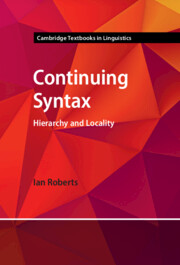Book contents
- Continuing Syntax
- Cambridge Textbooks in Linguistics
- Continuing Syntax
- Copyright page
- Contents
- Preface
- Abbreviations
- Part I Configuration and Hierarchy
- 1 Goals and Basic Assumptions
- 2 Hierarchy I: Phrase Structure and Grammatical Functions
- 3 Hierarchy II: C-Command, Head-Movement and Locality
- 4 Hierarchy and Categories I: Refining the Structure of the Clause and the VP
- 5 Hierarchy and Categories II: The Structure of Nominals
- 6 Case and the Nature of Infinitives
- 7 Features, Case and Agreement
- 8 Hierarchy and Linear Order
- 9 The Origins of Hierarchy: Bare Phrase Structure
- Part II Locality
- Glossary
- Book part
- Index
- References
2 - Hierarchy I: Phrase Structure and Grammatical Functions
from Part I - Configuration and Hierarchy
Published online by Cambridge University Press: 03 October 2025
- Continuing Syntax
- Cambridge Textbooks in Linguistics
- Continuing Syntax
- Copyright page
- Contents
- Preface
- Abbreviations
- Part I Configuration and Hierarchy
- 1 Goals and Basic Assumptions
- 2 Hierarchy I: Phrase Structure and Grammatical Functions
- 3 Hierarchy II: C-Command, Head-Movement and Locality
- 4 Hierarchy and Categories I: Refining the Structure of the Clause and the VP
- 5 Hierarchy and Categories II: The Structure of Nominals
- 6 Case and the Nature of Infinitives
- 7 Features, Case and Agreement
- 8 Hierarchy and Linear Order
- 9 The Origins of Hierarchy: Bare Phrase Structure
- Part II Locality
- Glossary
- Book part
- Index
- References
Summary
This chapter looks at the syntactic, i.e. phrase-structural, definitions of grammatical functions put forward in Chomsky (1965), which we restate using X-bar theory. We then submit these definitions to the ‘relational-grammar critique’, to adopt a term coined by Baker (2001), which suggests not just that Chomsky’s definitions are incorrect, but that something closer to the traditional idea that grammatical functions are primitives of syntactic theory is the right approach. One aspect of this critique is that constituency tests do not give clear results in many languages (English being something of an exception). Instead, we propose that asymmetries in c-command relations can provide us with a more reliable and general guide to constituency, and hence phrase-structural relations. This allows us to maintain a configurational definition of grammatical relations. In the final section of this chapter, we look at a construction which appears to centrally involve grammatical functions: the passive. We will see how the passive can be elegantly and usefully defined in purely phrase-structural terms. The conclusion is that grammatical relations can be reduced to phrase-structural relations, and as such are not primitive elements of syntactic theory. This is an important step in establishing the primacy of configurational, hierarchical, phrase-structural relations.
Information
- Type
- Chapter
- Information
- Continuing SyntaxHierarchy and Locality, pp. 29 - 54Publisher: Cambridge University PressPrint publication year: 2025
References
Primary Sources
Secondary Sources
Accessibility standard: WCAG 2.2 AAA
Content Navigation
Allows you to navigate directly to chapters, sections, or non‐text items through a linked table of contents, reducing the need for extensive scrolling.
Provides an interactive index, letting you go straight to where a term or subject appears in the text without manual searching.
Reading Order & Textual Equivalents
You will encounter all content (including footnotes, captions, etc.) in a clear, sequential flow, making it easier to follow with assistive tools like screen readers.
You get concise descriptions (for images, charts, or media clips), ensuring you do not miss crucial information when visual or audio elements are not accessible.
You get more than just short alt text: you have comprehensive text equivalents, transcripts, captions, or audio descriptions for substantial non‐text content, which is especially helpful for complex visuals or multimedia.
Visual Accessibility
You will still understand key ideas or prompts without relying solely on colour, which is especially helpful if you have colour vision deficiencies.
You benefit from high‐contrast text, which improves legibility if you have low vision or if you are reading in less‐than‐ideal lighting conditions.
